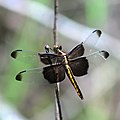Top Qs
Timeline
Chat
Perspective
Libellula
Genus of dragonflies From Wikipedia, the free encyclopedia
Remove ads
Libellula is a genus of dragonflies, called chasers (in England) or skimmers (in America), in the family Libellulidae. They are mainly distributed throughout the temperate zone of the Northern Hemisphere. Many have showy wing patterns and brightly colored bodies.[1][2]
Remove ads
Identification
These are medium to large dragonflies, 34–63 mm (1.3–2.5 in) in length. The faces of these dragonflies can be white, yellow, red, brown, or black. Their bodies can be light yellow, orange, red, or brown, and the males often have a frost-like coating when mature. Wings of the Libellula genus often have yellow, orange, or brown patterns, or they can be completely clear.[2]
Unique characteristics belonging only to the Libellula genus are not well defined. Many species or individual dragonflies have variations of these identifying traits. However, 4 synapomorphies are described, with 2 of them referring to the wing venation. The other 2 identifying features of the Libellula genus are a characteristic brown area at the base of the forewing and a wide abdomen.[2]
Remove ads
Distribution and habitat
Libellula dragonflies are generally distributed in the Northern Hemisphere. A few species are endemic to Europe and Asia, but much of the diversity of this genus in North America. L. herculea is the only species with an extensive distribution in South America.[2][3]
The adult Libellula are commonly found near bodies of water, perching or landing on reeds and branches. Larvae in the genus live exclusively in water, particularly in the muddy bottoms of still or slow-moving water bodies.[2] Some species, like L. pulchella, can live in drinking tanks of well-water for cattle, along with their natural habitat of ponds and marshes.[4]
Of the 27 species in the genus[5], 5 are currently listed on the IUCN Red List as threatened with extinction. L. angelina is listed as critically endangered, L. coahuiltecana is endangered, and L. jesseana is vulnerable. The other two species, L. mariae and L. pontica, are listed as near threatened.[6]
Remove ads
Biology

Eggs are laid by adult females directly into water bodies, which will hatch into aquatic nymphs. Libellula nymphs can compete for resources with other nymphs in their genus in a shared habitat. These nymphs can also cannibalize each other in high densities, and dragonflies are often the top predator in fishless water bodies.[7] Species within Libellula are efficient predators, using mechanical and visual cues to release their developed labium and labial palpi to catch their prey.[8]
Adult males in the Libellula genus can be territorial and aggressive. The territories they defend are ideal breeding sites, which are in sunlight and lacking surface vegetation. They fly around their territory and attack other male dragonflies to eliminate mating competition.[9] The males are likely territorial due to the sex-ratio being biased towards males, meaning that there are more males than females.[10]
Etymology
The genus name comes from Latin libella, meaning "a carpenter's level", because of the insect's ability to stay level when hovering.[11]
Taxonomy
The taxa Ladona (corporals) and Plathemis (whitetails) have been considered as synonyms of Libellula, subgenera, or separate genera by different authorities. However, recent phylogenetic analysis using 16S rRNA sequence data and insect morphology has supported their status as subgenera of Libellula rather than independent genera.[3][12]
Species
Summarize
Perspective
List of species.[13]
Extant species
Ladona
Plathemis
Remove ads
Fossils
- Libellula brodieri† [14]
- Libellula calypso† [14]
- Libellula doris †[14]
- Libellula eusebioi† [14]
- Libellula kieseli† [14]
- Libellula martini† [14]
- Libellula melobasis†
- Libellula pannewitziana† [14]
- Libellula perse† [14]
- Libellula sieboldiana† [14]
- Libellula thetis† [14]
- Libellula thoe† [14]
- Libellula ukrainensis† [14]
References
Wikiwand - on
Seamless Wikipedia browsing. On steroids.
Remove ads

















































